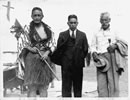Direct communication
Visiting London and meeting monarchs of the day reinforced the importance of royalty to Māori. The first visit was made by Moehanga (Ngāpuhi) when he met King George III in 1806. Moehanga was followed by others, including Hongi Hika, who met George IV in 1820, Hoani Wiremu Hīpango, who met Queen Victoria and Prince Albert in 1855, and the Māori King, Te Rata, who met George V in 1914.
Māori have a separate political relationship with the royal family because Queen Victoria was formally the British partner in the Treaty of Waitangi signed with chiefs in 1840, and from that flowed a relationship with the Crown.
Māori made numerous, sometimes successful, attempts to speak directly to the British monarch in the 19th and early 20th centuries. In 1831, a group of chiefs wrote to William IV, asking that he protect them from the French.
From the mid-19th century, Māori contact with the monarch often had the goal of getting colonial wrongs redressed. But attempts to go over the head of the New Zealand government, either in person or through letters and petitions, did not work. Requests received from Māori were passed on to the New Zealand governor or government, which generally dismissed them.
Local contact
Māori contact with royalty visiting New Zealand was carefully limited by governments of the day. Rotorua, home of Te Arawa (an iwi accustomed to entertaining and escorting tourists around the local thermal area, and which had sided with the government in the wars of the 1860s) was the venue of choice, from the 1901 visit by the Duke and Duchess of Cornwall and York onward. Other iwi were expected to gather there to welcome royalty. Displaying a harmonious relationship between Pākehā and Māori was one reason to gather at Rotorua. Another may have been the government’s ongoing attempt to develop the town as a fashionable spa resort.
Stop that train!
On 27 April 1927 the Māori King Te Rata, his entourage, and hundreds of Kingitanga supporters waited on the Ngāruawāhia railway platform. They hoped the Duke of York’s train would stop, despite the government’s refusal to agree to the prince meeting Māori outside Rotorua. The train went by without stopping.
Many iwi were sceptical of Te Arawa’s focus on entertaining Pākehā. Waikato Māori refused to officially attend the Rotorua welcomes, wanting to welcome the monarch on their own home ground – Tūrangawaewae in Ngāruawāhia. The New Zealand government firmly resisted this until the visit of Queen Elizabeth II in 1953. It was after this meeting (agreed to at the last minute) that a Māori king first swore allegiance to the British Crown.
Māori King movement
The King movement, started in 1856, was not primarily about copying the British monarchy, but was an attempt to prevent land sales, limit European colonisation and maintain rangatiratanga. A Māori monarch whose mana could match that of the English queen was the aim.
Idealists within the King movement saw it as a form of co-existence with Pākehā: ‘The King on his piece; the Queen on her piece; God over both; and Love binding them to each other.’1 Rather than seeing it this way, the New Zealand government saw the King movement as a direct challenge to the queen’s sovereignty and Pākehā governance.
Later 20th century
Māori demands that the Treaty of Waitangi be honoured were sometimes strongly expressed in the later 20th century. Radicals within Māoridom greeted the Prince and Princess of Wales with a whakapohane (bare-buttock salute – a traditional insult) in 1983 and the queen with calls to honour the treaty in 1990.
Whether Māori continued to have a strong interest in retaining a monarch as New Zealand’s head of state was questioned in the 2000s. Some public opinion surveys found Māori less committed to royalty than Pākehā.




